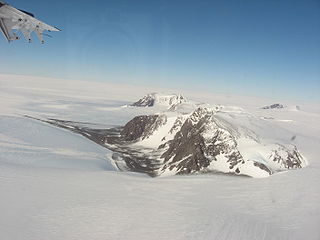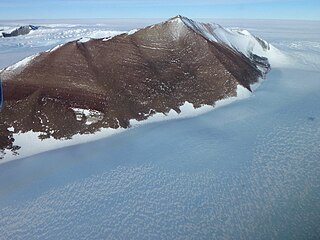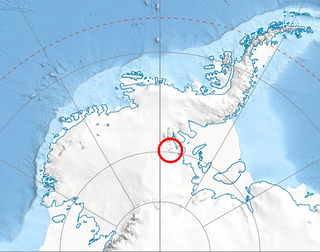Related Research Articles

The Thiel Mountains are isolated, mainly snow-capped mountains of the Transantarctic Mountains System, located in the Ellsworth Land region of Antarctica. The mountain range is 45 nautical miles long, is located roughly between the Horlick Mountains and the Pensacola Mountains, and extends from Moulton Escarpment on the west to Nolan Pillar on the east. Major components include Ford Massif, Bermel Escarpment and a group of eastern peaks near Nolan Pillar.

The Pensacola Mountains are a large group of mountain ranges and peaks that extend 280 nautical miles in a northeast–southwest direction in the Transantarctic Mountains System, Queen Elizabeth Land region of Antarctica. They comprise the Argentina Range, Forrestal Range, Dufek Massif, Cordiner Peaks, Neptune Range, Patuxent Range, Rambo Nunataks and Pecora Escarpment. These mountain units lie astride the extensive Foundation Ice Stream and Support Force Glacier which drain northward to the Ronne Ice Shelf.
The Neptune Range is a mountain range, 70 nautical miles long, lying west-southwest of Forrestal Range in the central part of the Pensacola Mountains, Antarctica. The range comprises Washington Escarpment with its associated ridges, valleys and peaks, the Iroquois Plateau, the Schmidt and the Williams Hills.

Palmer Land is the portion of the Antarctic Peninsula, Antarctica that lies south of a line joining Cape Jeremy and Cape Agassiz. This application of Palmer Land is consistent with the 1964 agreement between the Advisory Committee on Antarctic Names and the UK Antarctic Place-Names Committee, in which the name Antarctic Peninsula was approved for the major peninsula of Antarctica, and the names Graham Land and Palmer Land for the northern and southern portions, respectively. The line dividing them is roughly 69° S.
The Amundsen Glacier is a major Antarctic glacier, about 7 to 11 km wide and 150 km (80 nmi) long. It originates on the Antarctic Plateau where it drains the area to the south and west of Nilsen Plateau, then descends through the Queen Maud Mountains to enter the Ross Ice Shelf just west of the MacDonald Nunataks.

Minnesota Glacier is a broad glacier, about 40 nautical miles long and 5 nautical miles wide, flowing east through the Ellsworth Mountains in Antarctica, separating the Sentinel Range and the Heritage Range. It is nourished by ice from the plateau west of the mountains and by Nimitz Glacier and Splettstoesser Glacier, and merges into the larger Rutford Ice Stream at the eastern margin of the Ellsworth Mountains.

The Heritage Range is a major mountain range, 160 km (99 mi) long and 48 km (30 mi) wide, situated southward of Minnesota Glacier and forming the southern half of the Ellsworth Mountains in Antarctica. The range is complex, consisting of scattered ridges and peaks of moderate height, escarpments, hills and nunataks, with the various units of relief set off by numerous intervening glaciers.
Foundation Ice Stream is a major ice stream in the Pensacola Mountains of Antarctica. The ice stream drains northward for 150 nautical miles along the west side of the Patuxent Range and the Neptune Range to enter the Ronne Ice Shelf westward of Dufek Massif.
Siple Coast is the middle portion of the relatively ill-defined coast along the east side of the Ross Ice Shelf, between the north end of Gould Coast and the south end of Shirase Coast. The area was originally called Kirton Coast, but was renamed by NZ-APC in 1961 after Paul A. Siple, a noted American scientist-explorer who accompanied R. Admiral Richard E. Byrd on all of his Antarctic expeditions.
Lennox-King Glacier is a large valley glacier, about 40 nautical miles (70 km) long that flows east into the Ross Ice Shelf.

The Dufek Massif is a rugged, largely snow-covered massif 27 nautical miles long, standing west of the Forrestal Range in the northern part of the Pensacola Mountains, Antarctica.
Van der Veen Ice Stream, formerly Ice Stream B1, is a large southeastern tributary to the Whillans Ice Stream in Marie Byrd Land, Antarctica. Named by Advisory Committee on Antarctic Names (US-ACAN) after Cornelis J. "Kees" van der Veen, Byrd Polar Research Center and Departments of Geological Sciences and Geography, Ohio State University; glacial theoretician and collaborator with Ian Whillans, 1986–2001, in many seminal reports on the dynamics of the West Antarctic Ice Sheet, including former Ice Stream B, now Whillans Ice Stream.

Carey Glacier is a glacier on the east side of Miller and Fruzhin Peaks and west of Ruset and Malkoch Peaks in Petvar Heights at the southeast end of the Sentinel Range, Ellsworth Mountains, flowing southeast to Minnesota Glacier. It was mapped by the United States Geological Survey from surveys and from U.S. Navy air photos, 1957–59, and named by the Advisory Committee on Antarctic Names for Lieutenant David W. Carey, pilot with U.S. Navy Squadron VX-6, who was killed in the crash of a P2V Neptune airplane at McMurdo Sound in October 1956.
The Demas Range is a range about 8 nautical miles long that forms the lower east margin of the Berry Glacier in Marie Byrd Land, Antarctica. The range trends north–south culminating in Mount Goorhigian, 1,115 metres (3,658 ft) high.
Driscoll Glacier is a glacier 13 nautical miles (24 km) long in the Heritage Range, draining southeast between the Collier Hills and the Buchanan Hills to enter Union Glacier. It was mapped by the United States Geological Survey from surveys and U.S. Navy air photos, 1961–66, and was named by the Advisory Committee on Antarctic Names for Commander Jerome M. Driscoll, an administration officer with U.S. Navy Squadron VX-6 during Operation Deep Freeze 1965.
Gaussiran Glacier is a glacier in the eastern part of the Britannia Range, Antarctica. It drains north from the saddle with Merrick Glacier to a juncture with Darwin Glacier between the Cranfield Icefalls and the Nebraska Peaks. It is separated from Alley Glacier by a series of large rock buttresses, including Robertson Buttress.

Long Peak is a bare rock peak, 1,200 metres (4,000 ft) high, on the extended ridge line, 7 nautical miles (13 km) east-northeast of Mount Landolt in the Petvar Heights of the southeast Sentinel Range in the Ellsworth Mountains of Antarctica. It overlooks the lower courses of Drama Glacier to the north and Gabare Glacier to the south. The peak was mapped by the United States Geological Survey from surveys and U.S. Navy aerial photographs from 1957 to 1959, and was named by the Advisory Committee on Antarctic Names in 1984 after James W. Long, a National Science Foundation physician and consultant on Antarctic health matters for 10 years.
Schmidt Hills is a group of rock hills, 15 nautical miles long, lying north of Childs Glacier and west of Roderick Valley in the Neptune Range of the Pensacola Mountains, Antarctica.

The Liberty Hills are a line of rugged hills and peaks with bare rock eastern slopes, about 10 nautical miles (19 km) long, standing 7 nautical miles (13 km) northwest of the Marble Hills and forming part of the west wall of Horseshoe Valley, in the Heritage Range, Ellsworth Mountains, Antarctica. The Liberty Hills were mapped by the United States Geological Survey from ground surveys and U.S. Navy air photos, 1961–66. The name was applied by the Advisory Committee on Antarctic Names in association with the name Heritage Range. The remarkable High Nunatak towers east of the Hills.

Knutzen Peak is a sharp, rocky summit of elevation 3,373 metres (11,066 ft) standing on the north edge of Taylor Ledge in the Sentinel Range of the Ellsworth Mountains, Antarctica. It surmounts Branscomb Glacier to the east and south.
References
![]() This article incorporates public domain material from "Sponholz Peak". Geographic Names Information System . United States Geological Survey.
This article incorporates public domain material from "Sponholz Peak". Geographic Names Information System . United States Geological Survey.